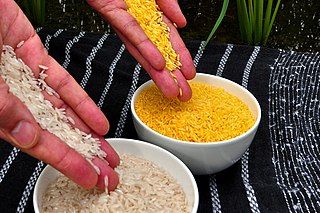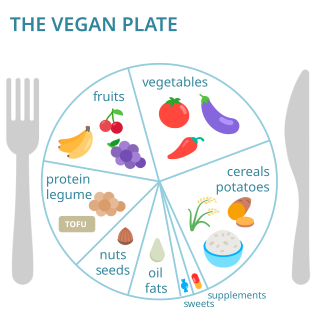Related Research Articles

Folate, also known as vitamin B9 and folacin, is one of the B vitamins. Manufactured folic acid, which is converted into folate by the body, is used as a dietary supplement and in food fortification as it is more stable during processing and storage. Folate is required for the body to make DNA and RNA and metabolise amino acids necessary for cell division and maturation of blood cells. As the human body cannot make folate, it is required in the diet, making it an essential nutrient. It occurs naturally in many foods. The recommended adult daily intake of folate in the U.S. is 400 micrograms from foods or dietary supplements.
Vitamin deficiency is the condition of a long-term lack of a vitamin. When caused by not enough vitamin intake it is classified as a primary deficiency, whereas when due to an underlying disorder such as malabsorption it is called a secondary deficiency. An underlying disorder can have 2 main causes:

White bread typically refers to breads made from wheat flour from which the bran and the germ layers have been removed from the whole wheatberry as part of the flour grinding or milling process, producing a light-colored flour.
Micronutrients are essential dietary elements required by organisms in varying quantities to regulate physiological functions of cells and organs. Micronutrients support the health of organisms throughout life.
Enriched flour is flour with specific nutrients added to it. These nutrients include iron and B vitamins. Calcium may also be supplemented. The purpose of enriching flour is to replenish the nutrients in the flour to match the nutritional status of the unrefined product. This differentiates enrichment from fortification, which is the process of introducing new nutrients to a food.

Iodised salt is table salt mixed with a minute amount of various salts of the element iodine. The ingestion of iodine prevents iodine deficiency. Worldwide, iodine deficiency affects about two billion people and is the leading preventable cause of intellectual and developmental disabilities. Deficiency also causes thyroid gland problems, including endemic goitre. In many countries, iodine deficiency is a major public health problem that can be cheaply addressed by purposely adding small amounts of iodine to the sodium chloride salt.

Helen Keller Intl is a US-based nonprofit organization that combats the causes and consequences of blindness and malnutrition by establishing programs based on evidence and research in vision, health, and nutrition. Founded in 1915 by Helen Keller and George A. Kessler, the organization's mission is to save the sight and lives of the most vulnerable and disadvantaged.
Food fortification or enrichment is the process of adding micronutrients to food. It can be carried out by food manufacturers, or by governments as a public health policy which aims to reduce the number of people with dietary deficiencies within a population. The predominant diet within a region can lack particular nutrients due to the local soil or from inherent deficiencies within the staple foods; the addition of micronutrients to staples and condiments can prevent large-scale deficiency diseases in these cases.

Folate deficiency, also known as vitamin B9 deficiency, is a low level of folate and derivatives in the body. This may result in megaloblastic anemia in which red blood cells become abnormally large, and folate deficiency anemia is the term given for this medical condition. Signs of folate deficiency are often subtle. Symptoms may include fatigue, heart palpitations, shortness of breath, feeling faint, open sores on the tongue, loss of appetite, changes in the color of the skin or hair, irritability, and behavioral changes. Temporary reversible infertility may occur. Folate deficiency anemia during pregnancy may give rise to the birth of low weight birth premature infants and infants with neural tube defects.

Vitamin A deficiency (VAD) or hypovitaminosis A is a lack of vitamin A in blood and tissues. It is common in poorer countries, especially among children and women of reproductive age, but is rarely seen in more developed countries. Nyctalopia is one of the first signs of VAD, as the vitamin has a major role in phototransduction; but it is also the first symptom that is reversed when vitamin A is consumed again. Xerophthalmia, keratomalacia, and complete blindness can follow if the deficiency is more severe.
Sight and Life is a think tank that focuses on eliminating malnutrition in children and women of childbearing age.

Biofortification is the idea of breeding crops to increase their nutritional value. This can be done either through conventional selective breeding, or through genetic engineering. Biofortification differs from ordinary fortification because it focuses on making plant foods more nutritious as the plants are growing, rather than having nutrients added to the foods when they are being processed. This is an important improvement on ordinary fortification when it comes to providing nutrients for the rural poor, who rarely have access to commercially fortified foods. As such, biofortification is seen as an upcoming strategy for dealing with deficiencies of micronutrients in low and middle-income countries. In the case of iron, the WHO estimated that biofortification could help cure the 2 billion people suffering from iron deficiency-induced anemia.

Nutrition International, formerly the Micronutrient Initiative (MI), is an international not for profit agency based in Canada that works to eliminate vitamin and mineral deficiencies in developing countries. Although often only required by the body in very small amounts, vitamin and minerals – also known as micronutrients – support an array of critical biological functions including growth, immune function and eye function, as well as foetal development of the brain, the nervous system, and the skeletal system. Micronutrient deficiency is a form of malnutrition and is a recognized health problem in many developing countries. Globally, more than two billion people live with vitamin and mineral deficiencies.
A Unifine mill is a single one-pass impact milling system which produces ultrafine-milled whole-grain wheat flour that requires no grain pre-treatment and no screening of the flour. Like the grist or stone mills that had dominated the flour industry for centuries, the bran, germ, and endosperm elements of grain are processed into a nutritious whole wheat flour in one step. Consumers had accepted whole wheat products produced by grist or stone mills. The flour produced by these mills was quite coarse as they included the bran and the germ elements of the grain.

Vegan nutrition refers to the nutritional and human health aspects of vegan diets. A well-planned vegan diet is suitable to meet all recommendations for nutrients in every stage of human life. Vegan diets tend to be higher in dietary fiber, magnesium, folic acid, vitamin C, vitamin E, and phytochemicals; and lower in calories, saturated fat, iron, cholesterol, long-chain omega-3 fatty acids, vitamin D, calcium, zinc, and vitamin B12.
Artificial rice is a grain product made to resemble rice. It is usually made from broken rice, sometimes with the addition of other cereals, and often fortified with micronutrients, including minerals, such as iron and zinc, and vitamins, such as vitamin A and vitamin B.
Indira Chakravarty is an Indian public health specialist, scholar, environmentalist, and 2014 recipient of the Padma Shri, the fourth highest civilian award by the Government of India, for her contributions to the fields of public health and environment.

A staple food, food staple, or simply staple, is a food that is eaten often and in such quantities that it constitutes a dominant portion of a standard diet for an individual or a population group, supplying a large fraction of energy needs and generally forming a significant proportion of the intake of other nutrients as well. For humans, a staple food of a specific society may be eaten as often as every day or every meal, and most people live on a diet based on just a small variety of food staples. Specific staples vary from place to place, but typically are inexpensive or readily available foods that supply one or more of the macronutrients and micronutrients needed for survival and health: carbohydrates, proteins, fats, minerals, and vitamins. Typical examples include grains, seeds, nuts and root vegetables. Among them, cereals, legumes and tubers account for about 90% of the world's food calorie intake.

BioAnalyt (BioAnalyt GmbH) is a privately held product-innovation company based in Teltow, Germany. The company focuses on developing, manufacturing, and marketing portable rapid test kits. Being sold under the name iCheck, the kits measure the concentration of vitamin A, total carotenoids, iron, or iodine in food and biological fluids. The test kits are easy to use, provide quantitative results within several minutes time. Displaying an innovative alternative to the established laboratory methods. In addition to products, BioAnalyt provides a broad spectrum of services connected with control of food quality or food fortification; which analyses of large-scale coverage studies in developing countries.

Vitamin B3, colloquially referred to as niacin, is a vitamin family that includes three forms, or vitamers: niacin (nicotinic acid), nicotinamide (niacinamide), and nicotinamide riboside. All three forms of vitamin B3 are converted within the body to nicotinamide adenine dinucleotide (NAD). NAD is required for human life and people are unable to make it within their bodies without either vitamin B3 or tryptophan. Nicotinamide riboside was identified as a form of vitamin B3 in 2004.
References
- 1 2 3 4 5 6 7 8 9 "Food Fortification Initiative spotlights lack of regulatory compliance as obstacle to progress". .nutritioninsight.com/. Retrieved 2024-09-03.
- 1 2 3 Murphy, Michaela E.; Westmark, Cara J. (2020). "Folic Acid Fortification and Neural Tube Defect Risk: Analysis of the Food Fortification Initiative Dataset". Nutrients. 12 (1): 247. doi: 10.3390/nu12010247 . ISSN 2072-6643. PMC 7019961 . PMID 31963665.
- 1 2 3 "Food Fortification Initiative". GAIN. Retrieved 2024-09-03.
- 1 2 3 "Fortification growing globally | World-grain.com | June 20, 2017 19:40 | World Grain". www.world-grain.com. Retrieved 2024-09-03.
- 1 2 "Preventing and controlling micronutrient deficiencies in populations affected by an emergency: multiple vitamin and mineral supplements for pregnant and lactating women, and for children aged 6 to 59 months". www.who.int. Retrieved 2024-09-03.
- 1 2 Stevens, Gretchen; Beal, Ty; Mbuya, Mduduzi; Luo, Hanqi; Neufeld, Lynnette (2022). "Micronutrient deficiencies among preschool-aged children and women of reproductive age worldwide: a pooled analysis of individual-level data from population-representative surveys". The Lancet. Global Health. 10 (11): e1590–e1599. doi:10.1016/S2214-109X(22)00367-9. PMC 10918648 . PMID 36240826.
- ↑ Semba, Richard D; Askari, Sufia; Gibson, Sarah; Bloem, Martin W; Kraemer, Klaus (2022-01-01). "The Potential Impact of Climate Change on the Micronutrient-Rich Food Supply". Advances in Nutrition. 13 (1): 80–100. doi:10.1093/advances/nmab104. ISSN 2161-8313. PMC 8803495 . PMID 34607354.
- ↑ "World". Food Fortification Initiative (FFI). Retrieved 2024-09-03.
- ↑ "Food fortification". www.who.int. Retrieved 2024-09-03.
- 1 2 "Supporting Nutrition: Donate to Fight Malnutrition". Food Fortification Initiative (FFI). Retrieved 2024-09-03.
- ↑ "26 U.S. Code § 501 - Exemption from tax on corporations, certain trusts, etc". LII / Legal Information Institute. Retrieved 2024-09-03.
- 1 2 "Our Work and Vision". Food Fortification Initiative (FFI). Retrieved 2024-09-03.
- 1 2 "Food_Fortification_Initiative_07-01-20_(public)". Google Docs. Retrieved 2024-09-03.
- 1 2 3 "New global initiative will harness food fortification to fight micronutrient deficiencies - Nutrition International". www.nutritionintl.org. 2022-10-21. Retrieved 2024-09-03.
- ↑ "Home". ISF Advisors.
- ↑ "Micronutrient Forum". Micronutrient Forum.
- ↑ "Global Fortification Data Exchange | GFDx – Providing actionable food fortification data all in one place".
- ↑ "Global Fortification Data Exchange | GFDx – Providing actionable food fortification data all in one place" . Retrieved 2024-09-03.
- ↑ "IFSBH - International Federation Spina Bifida and Hydrocephalus". IF Global.
- ↑ "Nouryon - Your partner in essential solutions for a sustainable future". Nouryon.
- ↑ "Smarter Futures, an African way to promote food fortification to help prevent Neural Tube Defects". IF Global. Retrieved 2024-09-03.
- ↑ "Homepage - Mühlenchemie - specialist flour / flour specialist". Mühlenchemie. February 21, 2023.
- ↑ "About us | Welcome to Smarter Futures". www.smarterfutures.net. Retrieved 2024-09-03.
- ↑ Mkambula, Penjani; Mbuya, Mduduzi N. N.; Rowe, Laura A.; Sablah, Mawuli; Friesen, Valerie M.; Chadha, Manpreet; Osei, Akoto K.; Ringholz, Corinne; Vasta, Florencia C.; Gorstein, Jonathan (2020). "The Unfinished Agenda for Food Fortification in Low- and Middle-Income Countries: Quantifying Progress, Gaps and Potential Opportunities". Nutrients. 12 (2): 354. doi: 10.3390/nu12020354 . ISSN 2072-6643. PMC 7071326 . PMID 32013129.
- ↑ "Asia-Pacific". Food Fortification Initiative (FFI). 2021-05-30. Retrieved 2024-09-03.
- ↑ Trade, corporateName= Department of Foreign Affairs and. "Australian High Commission in". solomonislands.embassy.gov.au. Retrieved 2024-09-03.
- 1 2 "Nutrition International and partners leverage food fortification to fight micronutrient deficiencies in the Philippines - Nutrition International". www.nutritionintl.org. 2024-02-05. Retrieved 2024-09-03.
- 1 2 Jones, Sina (September 16, 2019). "Regional Capacity Building Workshop for Flour Fortification". UNICEF.
- ↑ "Food Fortification Initiative". Fortify Health. Retrieved 2024-09-03.